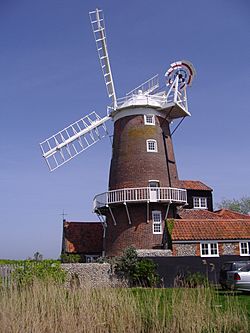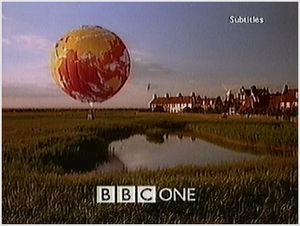Cley Windmill facts for kids
Quick facts for kids Cley Windmill |
|
|---|---|

The mill in 2008
|
|
| Origin | |
| Mill name | Cley Mill |
| Coordinates | 52°57′16″N 1°02′34″E / 52.95444°N 1.04278°E |
| Operator(s) | Private |
| Year built | Early 19th century |
| Information | |
| Purpose | Corn mill |
| Type | Tower mill |
| Storeys | Five storeys |
| No. of sails | Four sails |
| Type of sails | Double Patent sails |
| Windshaft | Cast iron |
| Winding | Fantail |
| Fantail blades | Eight blades |
| No. of pairs of millstones | Three pairs |
Cley Windmill is a famous old building in Cley next the Sea, Norfolk, England. It's a special type of windmill called a tower mill. Today, it's no longer used for grinding corn. Instead, it has been turned into a place where people can stay for holidays. It's even listed as a "grade II* listed" building, which means it's very important and protected.
Contents
The Story of Cley Windmill
Cley Windmill was built a long time ago, in the early 1800s. We know this because it wasn't on a map from 1797. The first time it was mentioned was in a newspaper ad in 1819. It was described as "newly built" and was owned by the Farthing family.
The Farthing family owned the mill until 1875. Then, a miller named Stephen Barnabas Burroughes bought it. His family worked the mill, grinding corn, until about 1912. After that, they moved their milling business to another windmill they owned.
From Mill to Holiday Home
In 1921, the Burroughes brothers sold the windmill to Mrs. Sarah Maria Wilson for £350. She decided to turn it into a holiday home. An architect named Cecil Upcher helped with the changes. All the old machinery inside the mill was taken out. Some of the big gear wheels were even cut in half and used as decorations!
In 1934, Lieutenant Colonel Hubert Blount inherited the mill. A big flood hit the area on January 31, 1953. The water inside the mill was at least 8 feet (2.4 meters) deep!
Later, in 1960, money was given by the Norfolk County Council and the Pilgrim Trust to help fix the mill's sails. The work cost £1,500, and special builders called millwrights did the job. Lieutenant Colonel Blount received more help in 1963 and 1971 to keep the mill in good shape.
A Famous Family Connection
Lieutenant Colonel Blount passed away in 1979. His youngest son, Colonel Charles Blount, then inherited the mill. Colonel Charles Blount is the father of the famous singer James Blunt. James Blunt spent a lot of time at Cley Windmill when he was a child.
In 1983, plans were approved to turn the windmill and its nearby buildings into a guesthouse. It opened its doors to guests on April 27, 1983.
More work was done on the mill in 1986-1987. The top part of the mill, called the cap, and its sails were repaired. This work cost a lot of money, but grants from English Heritage and Norfolk County Council helped pay for it. In 2006, the windmill was put up for sale for £1,500,000.
What is Cley Windmill Like?
Cley Windmill is a tall building with five floors. It has a platform, called a stage, on the second floor, about 20 feet (6 meters) above the ground. The very top of the mill, the cap, is shaped like a dome. It used to have an eight-bladed "fantail" that would turn the cap to face the wind. However, the cap is now fixed and doesn't turn anymore.
The mill has four large sails, which are 70 feet (21 meters) wide. These are called "double Patent sails." When the mill was first built in 1819, these sails powered two pairs of "French burr" millstones. These stones were used to grind corn into flour. By 1876, the mill had three pairs of stones and other machines to help with the milling process.
Who Worked at the Mill?
Here are some of the people who worked as millers at Cley Windmill:
- John Farthing (1819-1822)
- John Lee (1822-1848)
- William Edward Powell (1848-1850)
- Lawrence Randall (1853-1872)
- Stephen Barnabas Burroughes (1875-1900)
- Burroughes Bros (1900-1912)
Visiting Cley Windmill
Today, Cley Windmill is open to the public. You can stay there as a guest and enjoy a bed and breakfast experience.
Cley Windmill in Pop Culture

Cley Windmill has become a very famous symbol of North Norfolk. You can see its picture on many things, like tea towels, greeting cards, and even biscuit tins!
In 1998, the BBC (British Broadcasting Corporation) used Cley Windmill in one of its TV adverts. They showed a hot air balloon, which was their logo at the time, flying over different famous places in the UK. Cley Windmill was one of those special places, alongside Snowdon and the Forth Rail Bridge.
Cley Windmill is also a popular place for weddings. People can even have their wedding ceremony right there at the mill!

